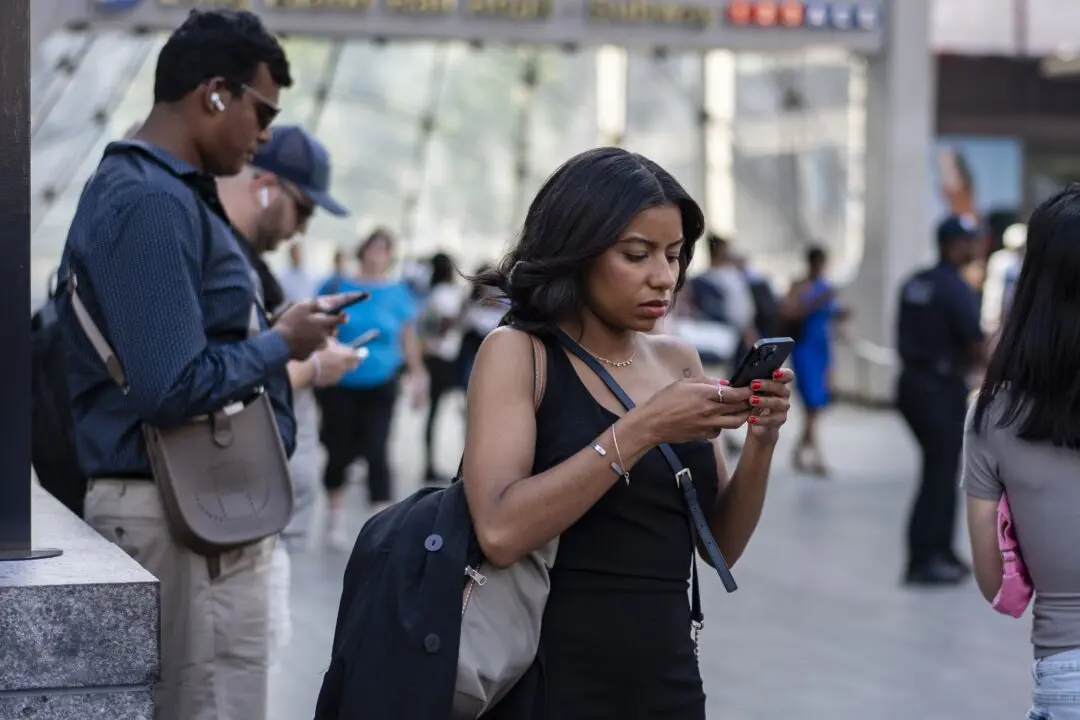Experts say there are health and wellness benefits from reducing screen time—but there’s a catch.

People with their phones in New York City on June 13, 2024.Samira Bouaou/The Epoch Times
The concept of digital “detoxing” has entered the mainstream, with wellness experts and scientists highlighting its considerable health benefits. Research from BMC suggests that even modest reductions in daily digital engagement can help alleviate symptoms of depression, enhance sleep quality, and lower cortisol levels for many people.
Studies examining the advantages of reducing or limiting different types of digital habits have gained momentum in recent years. Promising new results published by researchers at the University of Applied Sciences consistently show a link between less screen time and improved states of wellness.
BMC’s three-week analysis of 125 students who engaged in reduced screen time showed improvements in depressive symptoms, stress, sleep quality, and overall well-being. Once the control trial ended and digital engagement reached normal levels, researchers noted that the initial values of mental health symptoms began rising in lockstep.
Too much time spent online, particularly on social media platforms, has long been linked with negative mental health outcomes. However, evidence from a study produced by researchers from three Turkish universities suggests this extends to all types of digital connections.
Research from Cureus identifies this as “technostress,” a negative byproduct that stems from screen time. Examples include anxiety, irritability, frustration, and exhaustion. This is often associated with the psychological condition known as “fear of missing out,” or FOMO. The FOMO phenomenon is also a problem within the career space, according to the Turkish study, driving excessive smartphone engagement after the workday ends.
Harmony Healthcare IT conducted a smartphone screen time survey of more than 1,000 Americans and found that 60 percent who expressed a desire to cut back on their phone usage plan to replace phone time with a different activity, while 57 percent planned to delete “time-wasting” apps. Overall, 53 percent said they wanted to cut down on their smartphone usage in 2025. This represents a 33 percent increase from 2023.
Negative effects from excessive online activity aren’t disputed, but some experts say reduced screen time only carries lasting benefits if the lifestyle changes match.
Learning to Unplug
“Digital detoxing is not a quick fix. Screen use is a deeply ingrained habit, and lasting change comes from small, consistent adjustments rather than short periods of complete abstinence,” neuroscientist and author Emma Louth Als told The Epoch Times.
Louth Als said the problem with screen time isn’t necessarily the screen itself, but what it replaces. If digital engagement takes the place of proper socializing or rest, that’s when negative impacts on mental well-being start to appear.
“Screens are highly stimulating. They’re designed to keep you engaged, as the brain craves novelty and stimulation,” Louth Als said. “Taking time away allows your brain to slow down and recover.”
She said the pressure to always be “on” means the brain never truly rests. Reducing screen time gives your mind space to relax and lower stress levels.
Psychotherapist John McGuirk has also found this to be true when working with clients on digital detoxing.
“First, the quality of digital engagement itself can produce stress, such as repeatedly consuming negative news articles or finding oneself in online conflicts. This kind of engagement produces stress, low mood, or anxiety,” McGuirk told The Epoch Times.
“Secondly, the quantity of digital engagement can end up leaving very little time for other positive activities that might help improve well-being.”

Meta has unveiled plans to launch an ad-free subscription option for UK Facebook and Instagram users Alamy/PA
In his observations, McGuirk said this cycle prevents recovery from negative feelings.
“So, cortisol levels rise and stay high, and this negatively impacts heart rate, blood pressure, mood, and so on,” he said.
The amount of time people spend online has continued increasing since 2013, with overall screen time rising nearly 8 percent, according to an Exploding Topics analysis. On average, U.S. residents spend 7 hours, 3 minutes per day looking at digital screens.
Another Exploding Topics analysis showed U.S. teenagers spend almost half of their waking hours—7 hours, 22 minutes per day—looking at screens.
“When the brain is overloaded with notifications or content that leans on comparison, cortisol goes up in a state of hyperarousal until the nervous system gets a chance to settle,” psychologist Nick Bach told The Epoch Times.
Bach said his clients who take breaks from their devices report sleeping better, less irritation, and greater mental clarity within just a few days.
“I usually recommend that my clients try short and daily rituals such as the ‘screenless first hour’ or having an area in the home that is considered a tech-free zone. These shortcuts create a reset for someone without feeling deprived,” he said.
Jumping onto a smartphone first thing in the morning has been associated with increased stress and anxiety as well as reduced productivity, according to Blue Cross Blue Shield of Michigan.
McGuirk said creating “digital engagement windows,” such as five minutes at the end of every hour, is a healthy way of reducing screen time without creating too extreme a change.
However, he also believes it’s important to identify positive alternatives to being perpetually plugged in.
“This is vital and often missed. Just stopping leaves a huge window for ‘what do I do now?’ This can result in the old habit of ‘I’ve nothing to do, so I’ll just go online.’ Identifying good alternatives can include exercise, creativity, journaling, meditation, socializing [in real life], and going out into nature,” McGuirk said.

People run past the Department of State building in Washington on March 28, 2025. Madalina Vasiliu/The Epoch Times
Cainan Oliver, co-founder of wellness center Found Recovery, also takes this approach to digital detoxing.
“We don’t remove technology. We help people fill that space with something more real: connection, movement, art, time outside,” Oliver told The Epoch Times.
In his work with mental health and addiction, Oliver has observed a pattern.
“When clients start feeling grounded again, their relationship with screens shifts naturally,” he said.
Oliver believes that more people are starting to crave stillness over stimulation.
“We’ve spent years in overdrive, and our bodies are asking for balance,” he said. “Digital detoxing isn’t about rejecting technology. It’s about remembering how to feel connected to real life again.”
The Center for Internet & Technology Addiction reported the average smartphone user checks their phone 142 times per day—a 12 percent increase from 2024. The center also noted a 39 percent increase in ADHD diagnoses linked with “digital multitasking,” and social media users are more than three times as likely to experience depression.
Changing Habits
Louth Als says it’s difficult to change behavior patterns while in the same environment surrounded by the same cues. Eventually, people still need to check their work emails, upload homework assignments, and complete a multitude of other daily tasks that require screen time.
She emphasized that despite the benefits of a short-term digital detox, a one-off event won’t “reset the brain.”
“My husband and I have tried before but quickly fell back into old habits,” she said.
That’s because habits take time to change, according to Louth Als.
“Let’s say you eliminate digital engagement for a week or two. And then you reintroduce screens. You may keep it down for another week or so, but ultimately, you will come back to the same usage. Why? Because you have deeply ingrained neurocircuitry that finds it rewarding to interact with screens,” she explained.
Louth Als said real change comes from reshaping daily routines over weeks or months.
This is where daily digital reduction strategies come into play. Resetting the brain in a retreat setting is a great way to get rid of “mental clutter and physical tension,” according to Bach. However, small daily adjustments can help build a better mental health balance between the digital and physical world.
McGuirk gave an example, saying, “Set times when digital engagement is ruled out, like no digital engagement after 10 p.m.”
“I encourage people to think about their whole day and identify where screens take over. Once you spot those patterns, you can replace them with something more meaningful,” Louth Als said.
In the office, she suggests people turn off their email notifications and only look at emails when they’re ready to answer them.
“Otherwise, they cause stress,” she said. “When you read an email but don’t answer it, your brain uses energy thinking about it and remembering to answer it later. Too many small tasks like this cause stress.”
McGuirk said, “I regularly do digital detoxes and restrict my digital engagement. … I am much happier when my digital engagement is both quantitatively reduced and qualitatively improved.”
Bach also takes a quarterly 48 hour break from all devices, which allows him to come back feeling “grounded and ready to deeply connect with others and myself.”
Oliver said, “When I take time off my phone, I notice how quiet life actually is. My thoughts clear, and I start paying attention to the world again.”
